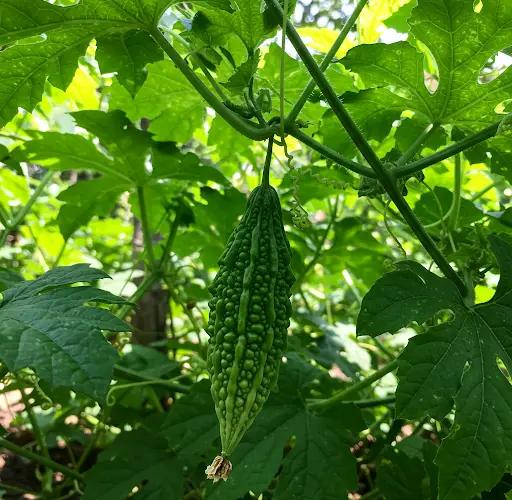Secrets to Growing Bitter Melon with Organic Kitchen Waste for Beginners – A Guide to a Bountiful Harvest
Bitter melon (Momordica charantia), also known as bitter gourd, is a nutrient-rich vegetable that thrives in warm climates. Many gardeners find it challenging to cultivate, but with the right techniques, you can grow an abundant crop using organic kitchen waste as fertilizer. This guide will walk you through the secrets to successfully growing bitter melon while recycling kitchen scraps to create nutrient-rich soil.
Why Grow Bitter Melon with Organic Kitchen Waste?
Using organic kitchen waste to grow bitter melon offers multiple benefits:
- Cost-effective – Reduces the need for store-bought fertilizers.
- Eco-friendly – Repurposes food scraps that would otherwise go to waste.
- Improves soil fertility – Organic matter enhances soil structure and nutrient content.
- Healthier produce – Avoids synthetic chemicals and promotes organic gardening.
If you’re a beginner, this method is simple, sustainable, and rewarding, allowing you to enjoy a consistent supply of homegrown bitter melons.
Choosing the Right Variety
Bitter melon comes in different shapes and sizes. Selecting the right variety depends on your climate and preferences:
- Chinese variety – Longer, smoother, and milder in bitterness.
- Indian variety – Shorter, spiky, and intensely bitter.
- Hybrid varieties – Disease-resistant and higher-yielding options are available.
Choose a variety suited to your region’s temperature and growing conditions to ensure a successful harvest.
Preparing the Soil with Organic Kitchen Waste
Bitter melon thrives in nutrient-rich, well-drained soil. Organic kitchen waste can enrich the soil naturally, promoting strong plant growth and fruit production.
Step 1: Collecting and Composting Kitchen Waste
Start by collecting organic food scraps such as:
- Fruit and vegetable peels (banana, cucumber, melon, and squash peels)
- Coffee grounds and tea leaves
- Crushed eggshells (for calcium)
- Leftover rice and bread (in small amounts)
Avoid adding dairy, meat, or oily food waste, as these can attract pests.
Step 2: Composting the Waste
- Dig a trench in your garden and bury the kitchen scraps about 6 inches deep.
- Cover with soil and let it decompose for at least 2-4 weeks.
- Alternatively, use a compost bin or worm composting system for faster decomposition.
Step 3: Preparing the Planting Bed
Once the composted waste has broken down into rich, dark soil, mix it into your garden bed or container soil. Ensure the soil has good drainage by adding sand or coconut coir if necessary.
Planting Bitter Melon Seeds
Step 1: Seed Selection and Preparation
For faster germination, follow these steps:
- Soak seeds in warm water for 24 hours.
- Wrap them in a damp paper towel and place them in a warm spot for 2-3 days until they sprout.
Step 2: Planting the Seeds
- Choose a sunny location, as bitter melon requires at least 6-8 hours of sunlight daily.
- Plant the seeds about ½ to 1 inch deep in well-prepared soil.
- Space plants 12-18 inches apart to allow proper vine growth.
Step 3: Providing a Trellis
Bitter melon is a climbing plant, so installing a trellis or vertical support will:
- Improve air circulation
- Prevent fruit from rotting on the ground
- Make harvesting easier
Use bamboo poles, wooden stakes, or a metal fence to create a sturdy trellis.
Watering and Fertilizing
Watering Tips
- Water deeply 2-3 times a week.
- Keep the soil consistently moist but not soggy to prevent root rot.
- Mulch around the plants to retain moisture and reduce weeds.
Fertilizing with Organic Waste
Enhance growth and fruiting by feeding bitter melon with homemade fertilizers:
- Banana peel tea – Soak banana peels in water for 24 hours and use the nutrient-rich liquid for watering.
- Eggshell powder – Crushed eggshells provide calcium, strengthening plant stems and fruits.
- Compost tea – Soak decomposed kitchen waste in water for a few days and use the liquid as a natural fertilizer.
Pest and Disease Management
Bitter melon can be affected by pests such as aphids, whiteflies, and cucumber beetles. Control them naturally by:
- Spraying neem oil or diluted soap water to deter pests.
- Planting companion plants like marigold and basil to repel insects.
- Handpicking larger pests and removing infected leaves.
To prevent fungal diseases, avoid overhead watering and ensure good airflow around the plants.
Encouraging More Fruit Production
- Pollination Assistance – Bitter melon has male and female flowers. If pollinators are scarce, hand-pollinate using a small brush.
- Pruning – Trim excessive vines to encourage energy flow towards fruit production.
- Regular Harvesting – Pick fruits when they are young (about 4-6 inches long) to encourage continuous fruiting.
Harvesting and Storage
Bitter melon is ready to harvest in about 60-70 days. Pick fruits when they are still green and firm for the best taste. Store harvested bitter melons in the refrigerator for up to a week or blanch and freeze them for long-term use.
Conclusion
Growing bitter melon using organic kitchen waste is a simple, sustainable, and highly productive gardening method. By recycling food scraps into nutrient-rich compost, providing proper care, and using natural pest control techniques, you can enjoy a bountiful harvest of this nutritious vegetable. Whether you’re a beginner or an experienced gardener, this eco-friendly approach will help you grow an abundance of bitter melons while reducing kitchen waste. Start your garden today and reap the benefits of fresh, homegrown produce!



